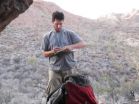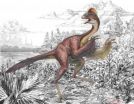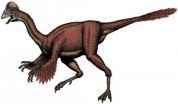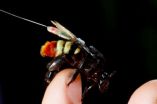(Press-News.org) RIVERSIDE, Calif. — Using ancient DNA analysis and other techniques, a research team led by conservation biologists at the University of California, Riverside has determined that bighorn sheep, so named for their massive spiral horns, became extinct on Tiburón Island, a large and mostly uninhabited island just off Sonora, Mexico, in the Gulf of California, sometime in the last millennium — specifically between the 6th and 19th centuries.
The result, published March 19 in PLOS ONE, is a surprise because conventional wisdom among wildlife biologists and the indigenous Seri people who long inhabited this coastal desert region was that bighorn sheep had not occupied Tiburón Island before 1975, when sixteen female and four male bighorn sheep were deliberately introduced. This introduction — viewed until now as an introduction of an alien species into a previously unoccupied ecosystem — was aimed at fostering a large, breeding population at a safe site that could be used in restocking the mainland, where historic land use decimated native bighorn sheep populations.
"Introduction success was expected on Tiburón Island, given the suitable habitat, lack of predators, absence of domestic sheep and their diseases, and minimal human disturbance," said Benjamin Wilder, a Ph.D. graduate student in UC Riverside's Department of Botany and Plant Sciences and the lead author of the study. "Indeed, by the mid-1990s, the Tiburón herd had grown to a stable population of 500 animals, one of the most successful large mammal introductions in the world."
The research got its start when in the spring of 2012 Wilder, along with a lab mate and his Seri collaborators, made an incidental discovery of a 1500-1600-year-old, urine-cemented dung mat on the floor of a small cave in the Sierra Kunkaak, a rugged mountain range of the eastern side of Tiburón Island. Subsequently, Jim Mead, a paleontologist at East Tennessee State University and a coauthor on the study, used his extensive dung collection of both living and extinct herbivores to determine that bighorn sheep formed the dung mat.
This determination was later confirmed by conservation geneticists at Oregon State University, who used specialized techniques to extract and sequence mitochondrial DNA from the ancient sheep pellets. The ancient sequences differed substantially from other large herbivores that might have been present. Further, the DNA sequences were not identical to the modern bighorn populations on Tiburón Island, giving confidence to the researchers' claim that the sequences do not derive from modern use of the cave by introduced bighorn sheep.
The discovery raises fascinating questions: How should the reintroduction of bighorn sheep on Tiburón Island be regarded? Is it a restoration or a biological invasion? The latter question also applies to most cases of rewilding and de-extinction efforts. Julio Betancourt, a USGS paleoecologist and co-author on the study, thinks that, in the future, "molecular caving, the application of molecular genetics to cave sediments, will become more than an afterthought to answer such questions in aridland paleoecology and conservation."
Wilder agrees. "With extended biological baselines, such as the knowledge that the Tiburón bighorn sheep went extinct before, it is possible to refine conservation targets," he said. "Given the cultural and conservation significance of the Tiburón bighorn, actions can be taken to avoid their past fate."
Wilder, Betancourt, and Mead were joined in the study by Clinton W. Epps and Rachel S. Crowhurst at Oregon State University; and Exequiel Ezcurra at UCR. Wilder works in Ezcurra's lab.
INFORMATION:
Funding for the study was provided by a UC MEXUS Dissertation Grant and a NSF Graduate Research Fellowship to Wilder.
The University of California, Riverside is a doctoral research university, a living laboratory for groundbreaking exploration of issues critical to Inland Southern California, the state and communities around the world. Reflecting California's diverse culture, UCR's enrollment has exceeded 21,000 students. The campus opened a medical school in 2013 and has reached the heart of the Coachella Valley by way of the UCR Palm Desert Center. The campus has an annual statewide economic impact of more than $1 billion. A broadcast studio with fiber cable to the AT&T Hollywood hub is available for live or taped interviews. UCR also has ISDN for radio interviews. To learn more, call (951) UCR-NEWS.
Bighorn sheep went extinct on desert island in Gulf of California, study finds
Until discovery by UC Riverside-led team, bighorn sheep were not known to have inhabited Tiburon Island -- changing a conservation paradigm
2014-03-19
ELSE PRESS RELEASES FROM THIS DATE:
A 'chicken from hell' dinosaur
2014-03-19
SALT LAKE CITY, March 19, 2014 – Scientists from Carnegie and Smithsonian museums and the University of Utah today unveiled the discovery, naming and description of a sharp-clawed, 500-pound, bird-like dinosaur that roamed the Dakotas with T. rex 66 million years ago and looked like an 11 ½-foot-long "chicken from hell."
"It was a giant raptor, but with a chicken-like head and presumably feathers. The animal stood about 10 feet tall, so it would be scary as well as absurd to encounter," says University of Utah biology postdoctoral fellow Emma Schachner, a co-author of ...
Smithsonian collaborates with paleontologist team to reveal new large, feathered dinosaur
2014-03-19
A team of scientists from the Smithsonian's National Museum of Natural History, the Carnegie Museum of Natural History and the University of Utah has described an unusual bird-like dinosaur previously unknown to science, resembling a cross between a modern emu and a reptile. The new species, Anzu wyliei, lived 68 to 66 million years ago and was identified from three partial skeletons collected from the Upper Cretaceous Hell Creek Formation in North and South Dakota. The species belongs to Oviraptorosauria, a group of dinosaurs mostly known from fossils found in Central ...
Paleontologists announce discovery of Anzu wyliei
2014-03-19
Pittsburgh, Pennsylvania…A team of researchers has announced the discovery of a bizarre, bird-like dinosaur, named Anzu wyliei, that provides paleontologists with their first good look at a dinosaur group that has been shrouded in mystery for almost a century. Anzu was described from three specimens that collectively preserve almost the entire skeleton, giving scientists a remarkable opportunity to study the anatomy and evolutionary relationships of Caenagnathidae (pronounced SEE-nuh-NAY-thih-DAY)—the long-mysterious group of theropod dinosaurs to which Anzu belongs. The ...
High-frequency breathing support for premature babies could lead to better lung function
2014-03-19
A new study led by researchers at King's College London has found that premature babies supported immediately after birth by high-frequency oscillation - a type of breathing support - had better lung function as adolescents than those who received conventional ventilation. The children ventilated with the high frequency method also showed higher academic achievement in three of eight school subjects.
The findings of the research, funded by the National Institute for Health Research (NIHR) Health Technology Assessment (HTA) Programme and the NIHR Biomedical Research Centre ...
Studies advance potential use Of MRI magnetic fields to treat balance disorders
2014-03-19
Expanding on earlier research, Johns Hopkins researchers report that people with balance disorders or dizziness traceable to an inner-ear disturbance show distinctive abnormal eye movements when the affected ear is exposed to the strong pull of an MRI's magnetic field.
The researchers first reported in 2011 in the journal Current Biology that an MRI's magnetic field pushes on the inner ear fluid responsible for maintaining balance, causing subjects undergoing MRI scans to have jerky eye movements and dizziness.
Two new studies now suggest that these strong magnets could ...
New guidelines deem 13 million more Americans eligible for statins
2014-03-19
DURHAM, N.C. – New guidelines for using statins to treat high cholesterol and prevent cardiovascular disease are projected to result in 12.8 million more U.S. adults taking the drugs, according to a research team led by Duke Medicine scientists.
The findings for the first time quantify the impact of the American Heart Association's new guidelines, which were issued in November and generated both controversy and speculation about who should be given a prescription for statins.
In an analysis of health data published online March 19, 2014, in the New England Journal ...
Tracking endangered leatherback sea turtles by satellite, key habitats identified
2014-03-19
AMHERST, Mass. ¬– A first-of-its-kind satellite tagging study of migrating New England leatherback turtles in the North Atlantic offers a greatly improved understanding of their seasonal high-use habitats, diving activity and response to key ocean and environmental features in relation to their search behavior. Leatherbacks are considered endangered species in all the world's oceans.
The study, part of doctoral research by Kara Dodge supervised by her advisor, Molly Lutcavage of the University of Massachusetts Amherst's Large Pelagics Research Center (LPRC) in Gloucester, ...
North Shore-LIJ Cancer Institute doctors' editorial published
2014-03-19
LAKE SUCCESS, NY – Two North Shore-LIJ Cancer Institute doctors, world-renowned for their research in chronic lymphocytic leukemia (CLL), weigh in on a German study of a new drug therapy for CLL in the March 20 edition of the New England Journal of Medicine, the North Shore-LIJ Health System announced today.
CLL is one of the most common forms of blood cancers, usually affecting those later in life. In an editorial written by Kanti Rai, MD, chief of CLL Research and Treatment Program for the health system, and Jacqueline Barrientos, MD, a research hematologist on staff ...
Dry future climate could reduce orchid bee habitat
2014-03-19
ITHACA, N.Y. – During Pleistocene era climate changes, neotropical orchid bees that relied on year-round warmth and wet weather found their habitats reduced by 30 to 50 percent, according to a Cornell University study that used computer models and genetic data to understand bee distributions during past climate changes.
In previous studies, researchers have tracked male and female orchid bees and found that while females stay near their nests, male orchid bees travel, with one study concluding they roam as far as 7 kilometers per day. These past findings, corroborated ...
Diabetes in middle age may lead to brain cell loss later in life
2014-03-19
MINNEAPOLIS – People who develop diabetes and high blood pressure in middle age are more likely to have brain cell loss and other damage to the brain, as well as problems with memory and thinking skills, than people who never have diabetes or high blood pressure or who develop it in old age, according to a new study published in the March 19, 2014, online issue of Neurology®, the medical journal of the American Academy of Neurology. Middle age was defined as age 40 to 64 and old age as age 65 and older.
"Potentially, if we can prevent or control diabetes and high blood ...
LAST 30 PRESS RELEASES:
Making lighter work of calculating fluid and heat flow
Normalizing blood sugar can halve heart attack risk
Lowering blood sugar cuts heart attack risk in people with prediabetes
Study links genetic variants to risk of blinding eye disease in premature infants
Non-opioid ‘pain sponge’ therapy halts cartilage degeneration and relieves chronic pain
AI can pick up cultural values by mimicking how kids learn
China’s ecological redlines offer fast track to 30 x 30 global conservation goal
Invisible indoor threats: emerging household contaminants and their growing risks to human health
Adding antibody treatment to chemo boosts outcomes for children with rare cancer
Germline pathogenic variants among women without a history of breast cancer
Tanning beds triple melanoma risk, potentially causing broad DNA damage
Unique bond identified as key to viral infection speed
Indoor tanning makes youthful skin much older on a genetic level
Mouse model sheds new light on the causes and potential solutions to human GI problems linked to muscular dystrophy
The Journal of Nuclear Medicine ahead-of-print tip sheet: December 12, 2025
Smarter tools for peering into the microscopic world
Applications open for funding to conduct research in the Kinsey Institute archives
Global measure underestimates the severity of food insecurity
Child survivors of critical illness are missing out on timely follow up care
Risk-based vs annual breast cancer screening / the WISDOM randomized clinical trial
University of Toronto launches Electric Vehicle Innovation Ontario to accelerate advanced EV technologies and build Canada’s innovation advantage
Early relapse predicts poor outcomes in aggressive blood cancer
American College of Lifestyle Medicine applauds two CMS models aligned with lifestyle medicine practice and reimbursement
Clinical trial finds cannabis use not a barrier to quitting nicotine vaping
Supplemental nutrition assistance program policies and food insecurity
Switching immune cells to “night mode” could limit damage after a heart attack, study suggests
URI-based Global RIghts Project report spotlights continued troubling trends in worldwide inhumane treatment
Neutrophils are less aggressive at night, explaining why nighttime heart attacks cause less damage than daytime events
Menopausal hormone therapy may not pose breast cancer risk for women with BRCA mutations
Mobile health tool may improve quality of life for adolescent and young adult breast cancer survivors
[Press-News.org] Bighorn sheep went extinct on desert island in Gulf of California, study findsUntil discovery by UC Riverside-led team, bighorn sheep were not known to have inhabited Tiburon Island -- changing a conservation paradigm




